.png)
1) 트리
트리의 특징
- 노드 개수 :
n개이면 간선 개수 :n-1개가 된다. Cycle를 이루지 않는다.- 두 Node간의 경로가 유일하게 나온다.
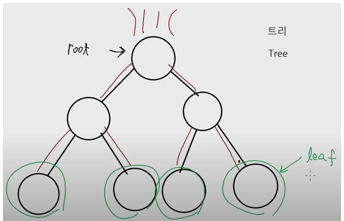
Binary Tree(2진 트리)
2진트리의 특징
- 트리의 왼쪽 자손은 현재 node의
2배랑 같다. - 트리의 오른쪽 자손은 현재 node의
2배 + 1과 같다.

2) DFS
인접 행렬 방식
#include <iostream>
using namespace std;
int arr[100][100] = { 0 };
int nodeCnt;
int used[100];
void func(int now) {
cout << now << " ";
// 한 Node에서 갈 수 있는 node가 2개 이상일 경우 작은 번호의 node 부터
for (int to = 1; to <= nodeCnt; to++) {
// 이미 node에 왔었다면 무시 -> 중복(Cycle) 피하기
if(used[to] != 0) continue;
// now -> to로 갈 수 없으면 무시
if (arr[now][to] == 0) continue;
used[to] = 1; // 도착한 node 기록
func(to);
}
}
int main() {
// Node 개수
cin >> nodeCnt;
// Node 개수만큼의 Node 정보
// 트리의 간선 수 : 노드 - 1
for (int i = 0; i < nodeCnt - 1; i++) {
int from, to;
cin >> from >> to;
// 인접행렬 방식
arr[from][to] = 1;
}
used[10] = 1;
// root를 10으로 설정
func(10);
return 0;
}| 입력 | 그래프 | 출력(경로) |
|---|---|---|
 |  |  |
인접 리스트 방식
#include <iostream>
#include <vector>
using namespace std;
vector<int> v[100];
int nodeCnt;
int used[100];
void func(int now) {
cout << now << " ";
// 한 Node에서 갈 수 있는 node가 2개 이상일 경우 먼저 입력받은 node 부터
for (int i = 0; i < v[now].size(); i++) {
int to = v[now][i];
// 이미 node에 왔었다면 무시 -> 중복(Cycle) 피하기
if (used[to] != 0) continue;
used[i] = 1; // 도착한 node 기록
func(to);
}
}
int main() {
// Node 개수
cin >> nodeCnt;
// Node 개수만큼의 Node 정보
// 트리의 간선 수 : 노드 - 1
for (int i = 0; i < nodeCnt - 1; i++) {
int from, to;
cin >> from >> to;
// 인접리스트 방식
v[from].push_back(to);
}
used[10] = 1;
// root를 10으로 설정
func(10);
return 0;
}| 입력 | 그래프 | 출력(경로) |
|---|---|---|
 | 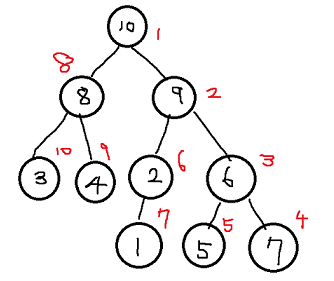 |  |
3) 특정 목적지까지 가는 방법의 수
인접 행렬 방식
0번에서 출발하여 3번까지 가는 경로의 개수 구하기
#include <iostream>
using namespace std;
int arr[100][100] = { 0 };
int nodeCnt,edgeCnt;
int used[100];
int cnt;
void func(int now) {
// 3에 도착하게 되면 카운트
if (now == 3) {
cnt++;
return;
}
for (int to = 0; to <= nodeCnt; to++) {
// 이미 node에 왔었다면 무시 -> 중복(Cycle) 피하기
if (used[to] != 0) continue;
// now -> to로 갈 수 없으면 무시
if (arr[now][to] == 0) continue;
used[to] = 1; // 도착한 node 기록
func(to);
used[to] = 0; // 다양한 경로로 이동이 가능토록 하기 위해
}
}
int main() {
// Node 개수 와 간선 개수
cin >> nodeCnt >> edgeCnt;
// 간선 개수만큼의 Node 정보
for (int i = 0; i < edgeCnt; i++) {
int from, to;
cin >> from >> to;
// 인접행렬 방식
arr[from][to] = 1;
}
used[0] = 1;
// root를 0으로 설정
func(0);
// 경로 개수
cout << cnt;
return 0;
}인접 리스트 방식
#include <iostream>
#include <vector>
using namespace std;
vector<int> v[100];
int nodeCnt,edgeCnt;
int used[100];
int cnt;
void func(int now) {
// 3에 도착하게 되면 카운트
if (now == 3) {
cnt++;
return;
}
for (int i = 0; i < v[now].size(); i++) {
int to = v[now][i];
// 이미 node에 왔었다면 무시 -> 중복(Cycle) 피하기
if (used[to] != 0) continue;
used[to] = 1; // 도착한 node 기록
func(to);
used[to] = 0; // 다양한 경로로 이동이 가능토록 하기 위해
}
}
int main() {
// Node 개수 와 간선 개수
cin >> nodeCnt >> edgeCnt;
// 간선 개수만큼의 Node 정보
for (int i = 0; i < edgeCnt; i++) {
int from, to;
cin >> from >> to;
// 인접리스트 방식
v[from].push_back(to);
}
used[0] = 1;
// root를 0으로 설정
func(0);
// 경로 개수
cout << cnt;
return 0;
}| 입력 | 그래프 | 출력(경로) |
|---|---|---|
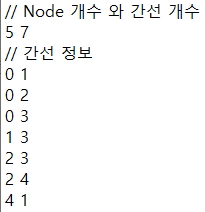 | 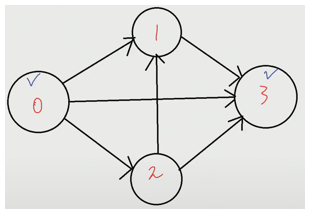 | 4 |
3) 최대 거리 / 최소 거리
0번에서 출발하여 3번까지 가는 최대 / 최소 거리 구하기
인접 행렬 방식
#include <iostream>
using namespace std;
int arr[100][100] = { 0 };
int nodeCnt, edgeCnt;
int used[100];
int sum;
int minCost = 21e8;
int maxCost = -21e8;
void func(int now) {
// 3에 도착하게 되면 최대,최소 거리 구하기
if (now == 3) {
if (minCost > sum) minCost = sum;
if (maxCost < sum) maxCost = sum;
return;
}
for (int to = 0; to < nodeCnt; to++) {
// 이미 node에 왔었다면 무시 -> 중복(Cycle) 피하기
if (used[to] != 0) continue;
// now -> to로 갈 수 없으면 무시
if (arr[now][to] == 0) continue;
used[to] = 1; // 도착한 node 기록
sum += arr[now][to];
func(to);
used[to] = 0; // 다양한 경로로 이동이 가능토록 하기 위해
sum -= arr[now][to];
}
}
int main() {
// Node 개수 와 간선 개수
cin >> nodeCnt >> edgeCnt;
// 간선 개수만큼의 Node 정보
for (int i = 0; i < edgeCnt; i++) {
int from, to, cost;
// 출발 , 목적지 , 거리
cin >> from >> to >> cost;
// 인접행렬 방식
arr[from][to] = cost;
}
used[0] = 1;
// root를 0으로 설정
func(0);
// 최소 최대 거리
cout << minCost << " " << maxCost << endl;
return 0;
}인접 리스트 방식
#include <iostream>
#include <vector>
using namespace std;
// 구조체 생성
struct Edge {
// 목적지 , 거리
int to;
int cost;
};
vector<Edge> v[100];
int nodeCnt,edgeCnt;
int used[100];
int sum;
int minCost = 21e8;
int maxCost = -21e8;
void func(int now) {
// 3에 도착하게 되면 최대,최소 거리 구하기
if (now == 3) {
if (minCost > sum) minCost = sum;
if (maxCost < sum) maxCost = sum;
return;
}
for (int i = 0; i < v[now].size(); i++) {
Edge edge = v[now][i];
int to = edge.to;
int cost = edge.cost;
// 이미 node에 왔었다면 무시 -> 중복(Cycle) 피하기
if (used[to] != 0) continue;
used[to] = 1; // 도착한 node 기록
sum += cost;
func(to);
used[to] = 0; // 다양한 경로로 이동이 가능토록 하기 위해
sum -= cost;
}
}
int main() {
// Node 개수 와 간선 개수
cin >> nodeCnt >> edgeCnt;
// 간선 개수만큼의 Node 정보
for (int i = 0; i < edgeCnt; i++) {
int from, to, cost;
cin >> from >> to >> cost;
// 인접리스트 방식
v[from].push_back({to,cost}); // 목적지, 거리 입력
}
used[0] = 1;
// root를 0으로 설정
func(0);
// 최소 최대 거리
cout << minCost << " " << maxCost << endl;
return 0;
}| 입력 | 그래프 | 출력(경로) |
|---|---|---|
 | 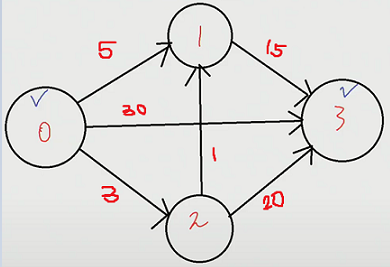 |  |
